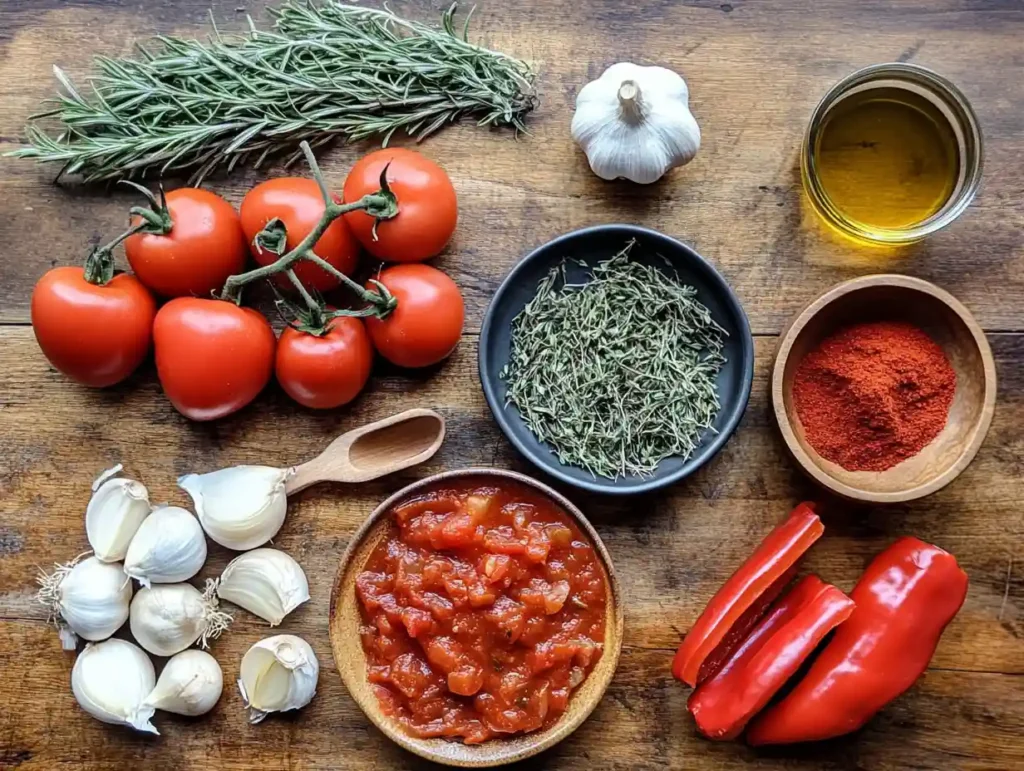Learn how to thicken cacciatore sauce easily. Follow these steps, choose the right thickener, and create a perfectly rich, flavorful dinner.
Furthermore, it’s about balancing flavor, richness, and texture. Particularly, the right thickness can highlight the sauce’s robust flavors—tomatoes, garlic, wine, and herbs—while gently hugging tender chicken pieces.
In this guide, we will explore multiple approaches. Undoubtedly, there are traditional methods, modern twists, and healthier substitutions. Equally, we will discuss common mistakes and show you how professionals handle it. Consequently, you will learn how to thicken cacciatore sauce no matter the situation.
Table of contents
Understanding How to Thicken Cacciatore Sauce from Scratch
Cacciatore, meaning “hunter-style,” often includes braised chicken or rabbit cooked in a savory tomato-based sauce. Initially, the sauce comes together from simmering tomatoes, onions, garlic, and sometimes bell peppers. However, it may remain somewhat thin if you do not apply the right technique. Consequently, achieving that thick, glossy finish requires focus on moisture control.
Because simmering removes excess liquid, it concentrates flavors. However, this process can take time. Meanwhile, other quick fixes, like adding a slurry of flour or cornstarch, can deliver immediate results. Another option is incorporating tomato paste. Thus, you have many tools at your disposal.
When you know how to thicken cacciatore sauce, you unlock more than texture. Basically, you ensure each component blends harmoniously. Comparatively, without proper thickness, the sauce might run off the meat, leaving an unbalanced plate. Thus, thickness helps marry flavors, ensuring uniform seasoning from start to finish.
Common Thickening Agents for How to Thicken Cacciatore Sauce
When considering how to thicken cacciatore sauce, you have many options. Initially, flour has been a classic thickener. Additionally, a roux—equal parts butter and flour—adds richness. Conversely, cornstarch slurry remains a favorite because it thickens quickly and does not add much flavor. Moreover, arrowroot or potato starch can serve as gluten-free substitutes, creating a glossy finish with neutral taste.
- Flour or roux:
- Chiefly used in European sauces.
- Adds a subtle, creamy mouthfeel.
- Cook thoroughly to remove raw flour taste.
- Cornstarch:
- Generally provides a clear, shiny finish.
- Thickens rapidly at a simmer.
- Use a small amount to avoid a gummy texture.
- Arrowroot or tapioca starch:
- Equally good for gluten-free diets.
- Does not cloud the sauce.
- Works well at lower temperatures.
- Tomato paste:
- Concentrates tomato flavor.
- Naturally thickens because it’s reduced tomato.
- Adds richness and color.
- Pureed vegetables:
- Basically blends in seamlessly.
- Adds body, fiber, and subtle sweetness.
- Consider carrot, celery, or onion puree.
By mixing and matching these elements, you gain control over thickness and flavor. Particularly, if you aim for a healthier approach, choose pureed veggies or arrowroot. Conversely, if you want an old-fashioned Italian approach, try a roux and slow reduction.
Step-by-Step Instructions on How to Thicken Cacciatore Sauce the Old-Fashioned Way

- Simmer and Reduce:
Initially, bring your sauce to a gentle boil, then reduce to a simmer. Consequently, water evaporates. Eventually, the sauce thickens naturally. However, be patient, as this might take 20 to 30 minutes. Meanwhile, stir occasionally to prevent burning. - Add a Beurre Manié:
Beurre manié is a paste of equal parts butter and flour. Particularly, knead them together until smooth. Then, whisk small portions into your simmering sauce. Thus, it thickens gradually, adding a velvety texture. Conversely, add it slowly to avoid lumps. - Incorporate Tomato Paste:
Tomato paste offers a concentrated hit of flavor and thickness. Basically, start with a spoonful. However, add more if needed. Substantially, this method preserves the rich tomato character and requires no additional starch. - Blend in Cooked Vegetables:
Afterward, consider blending some cooked onions, carrots, or mushrooms. Consequently, they add body and creaminess without extra fat or starch. Basically, pureeing them into the sauce boosts thickness and flavor. - Check Consistency and Seasoning:
Particularly important, taste and adjust seasoning. Furthermore, ensure that the thickness matches your preference. Finally, add salt, herbs, or a splash of wine if needed. Hence, you have full control over your final product.
Modern Twists for a Perfectly Thickened Sauce
In today’s kitchens, cooks experiment with innovative methods. Accordingly, gluten-free and low-carb diets have inspired new thickeners. For example, arrowroot or tapioca starch works well if you cannot have wheat. Meanwhile, xanthan gum—used sparingly—provides thickness without affecting flavor. Moreover, pureed legumes like white beans add creaminess and protein.
- Gluten-Free Starches:
- Arrowroot and tapioca excel at providing silky textures.
- Work well in sauces that must remain shiny and clear.
- Xanthan Gum:
- Use tiny amounts.
- Thickens without heat.
- Ideal for those avoiding starches altogether.
- Dairy-Free Creaminess:
- Pureed cashews create a rich texture without cream.
- White bean purees add nutrients and subtle flavors.
- Equally effective for vegan or lactose-intolerant diners.
When learning how to thicken cacciatore sauce, do not hesitate to try these modern twists. Conversely, remember to adjust seasonings. Because some thickeners are flavor-neutral, you may need a touch of salt or herbs to maintain balance.
Troubleshooting Common Sauce Issues
Occasionally, problems arise. For instance, you might wonder if you over-thickened the sauce. Nevertheless, thinning it out is simple. Comparatively, you can add a splash of broth, tomato sauce, or even a bit of wine. Consequently, it returns to a pourable consistency. Meanwhile, if the sauce remains watery, add a bit more thickener or reduce it further.
Sometimes flavor concentration can shift. Specifically, as the sauce thickens, flavors intensify. Thus, if it becomes too strong, add a small amount of water or broth. Alternatively, if the sauce tastes dull, incorporate a pinch of salt, a drizzle of olive oil, or fresh herbs. Indeed, each adjustment ensures a perfect balance.
If lumps form, whisk vigorously or strain the sauce through a fine-mesh sieve. Eventually, lumps disappear, leaving a smooth texture. Another approach is to use an immersion blender to fix both thickness and lumpiness. Ultimately, patience and tasting at each stage guarantee your sauce turns out beautifully.
Balancing Flavor While Thickening Your Sauce
When you consider how to thicken cacciatore sauce, it’s not just about texture. Equally important, proper seasoning ensures a balanced taste. Specifically, as you reduce liquids, flavors can become stronger. Therefore, taste after each step. Further, adjust salt, pepper, or herbs as needed.
If sweetness overpowers, add a bit of acidity, such as a splash of lemon juice or red wine vinegar. Conversely, if acidity dominates, stir in a pinch of sugar. Comparatively, if bitterness emerges, consider adding a teaspoon of butter or a little tomato paste. Thus, each small tweak brings you closer to the perfect sauce.
The key lies in layering flavors. Initially, start with quality ingredients. Thus, a well-made stock, fresh tomatoes, and aromatics form the foundation. Eventually, as you thicken, taste often. Consequently, you will ensure that the final dish remains balanced, rich, and pleasing to the palate.
Chef-Approved Tips for Perfect Consistency
Professional chefs excel at achieving perfect texture. Generally, they start with high-quality ingredients to ensure a good foundation. Subsequently, they employ gentle simmering and careful stirring. Another trick involves adding thickeners gradually. Indeed, adding too much at once can lead to gluey results.
Chefs also rely on proper timing. Specifically, they add thickening agents toward the end, adjusting as needed. Equally, they use tools like whisks and strainers for a flawless finish. Furthermore, they keep tasting, ensuring the sauce matches their vision. Essentially, mastering how to thicken cacciatore sauce is an art that blends culinary science with creativity.
Chefs emphasize patience, too. Consequently, rushing the process can lead to uneven textures or raw flour tastes. Therefore, low and slow simmering helps flavors meld. Likewise, a touch of high-quality olive oil or butter at the end can add polish and depth. Eventually, by following these insights, home cooks can achieve chef-like results.
Cacciatore Sauce Recipe with Easy Thickening Steps

Below is a simple recipe that demonstrates how to thicken cacciatore sauce naturally. Meanwhile, feel free to adapt ingredients to your preference.
Ingredients (for 4 servings):
- 🍗 4 bone-in chicken thighs, skin-on
- 🍅 1 can (14 oz) crushed tomatoes
- 🍄 1 cup sliced mushrooms
- 🌶 1 red bell pepper, chopped
- 🧅 1 medium onion, diced
- 🧄 2 cloves garlic, minced
- 🍷 1/2 cup dry red wine (optional)
- 🌿 1 tablespoon chopped fresh rosemary
- 🌱 1 tablespoon chopped fresh thyme
- 🧂 Salt and pepper to taste
- 🧈 1 tablespoon butter + 1 tablespoon flour (beurre manié) or 2 teaspoons cornstarch mixed with 2 teaspoons water for thickening
Instructions:
- Season chicken with salt and pepper.
- Heat a drizzle of olive oil in a large skillet over medium-high heat.
- Add chicken and brown on all sides. Remove chicken and set aside.
- Add onion, garlic, mushrooms, and bell pepper to the skillet. Sauté until softened.
- Pour in the wine, scraping up browned bits. Let it simmer until reduced by half.
- Stir in crushed tomatoes and herbs. Return chicken to the pan.
- Cover and simmer on low heat for about 30 minutes until chicken is cooked through.
- Remove chicken. Now, assess the sauce consistency.
- If it’s too thin, whisk in the beurre manié or cornstarch slurry. Simmer until thickened. Adjust seasoning if needed.
- Return chicken to the sauce and serve over pasta or polenta.
Tips:
- If the sauce gets too thick, add a splash of broth.
- If it’s too thin, reduce it longer or add more thickener.
- Taste often and adjust seasoning accordingly.
Frequently Asked Questions
How do professional chefs handle how to thicken cacciatore sauce?
Professional chefs rely on classic techniques. Essentially, they often simmer the sauce until it reduces and thickens naturally. Moreover, they might add a beurre manié for a smooth, rich thickness. Additionally, they pay attention to flavor. Accordingly, they taste frequently and adjust seasonings as the sauce thickens. Because their experience guides them, they know precisely when to stop simmering and how to maintain the perfect balance.
What naturally thickens sauce when learning how to thicken cacciatore sauce?
Tomato paste and pureed vegetables are natural options. Furthermore, these add complexity and body without processed starches. Particularly, carrots, onions, or even roasted red peppers can blend into the sauce. Consequently, their natural fibers provide thickness. Additionally, tomato paste acts as a concentrated tomato essence, enriching flavor and giving the sauce a thicker consistency.
What is the healthiest substitute for cornstarch while exploring how to thicken cacciatore sauce?
Arrowroot, tapioca starch, or pureed beans are great cornstarch alternatives. Chiefly, arrowroot provides a gluten-free, flavorless thickening. Thus, it suits those with dietary restrictions. Similarly, pureed white beans add thickness and protein. Consequently, these methods avoid refined starches and enhance nutritional value. Meanwhile, the sauce remains delicious and creamy, aligning with health-conscious goals.
How to thicken piccata sauce?
Piccata sauce differs slightly from cacciatore. Nevertheless, some methods overlap. Initially, simmer to reduce excess liquid. Subsequently, swirl in a small knob of butter and a teaspoon of flour if needed. Thus, it thickens gently. Conversely, you can add a cornstarch slurry. However, be careful not to alter piccata’s bright, lemony flavor. Furthermore, always taste after thickening and adjust seasonings.
Final Thoughts on Creating a Perfect Sauce
Ultimately, mastering how to thicken cacciatore sauce empowers you to create restaurant-quality meals. Because thickness enhances the dining experience, you can transform humble ingredients into something memorable. Accordingly, whether you use traditional methods, modern alternatives, or natural thickeners, the result depends on patience and creativity.
Finally, never forget to taste and adjust. Undoubtedly, every kitchen, stove, and palate differs. Hence, by applying these techniques and experimenting, you develop your own signature style. Particularly, as you gain confidence, you will know instinctively which thickener to choose. Thus, your cacciatore sauce will always impress, delighting family and friends alike.
